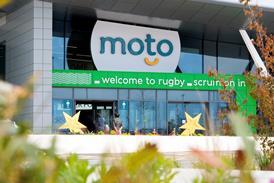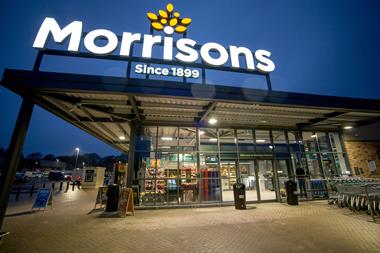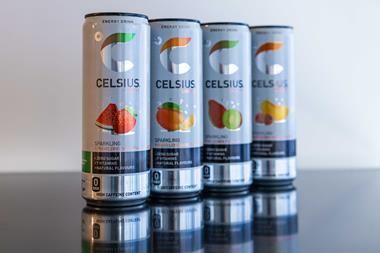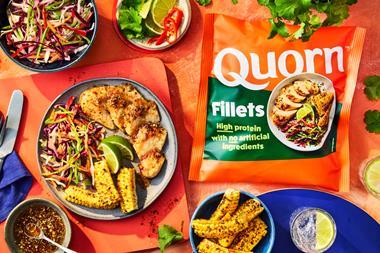Despite the recession, wholesalers are continuing to invest in new fascias. So why have they decided now is the time to rebrand, and what effect is it having? Beth Phillips reports
Image is everything, as the saying goes. And it seems the nation's wholesalers agree, with Nisa-Today's, Booker and Palmer & Harvey all giving their symbol fascias a facelift in the past few months.
Nisa-Today's unveiled a new contemporary look for its Nisa Local fascia in November. Booker's Premier symbol was relaunched - complete with a new format for smaller stores - in March. And Palmer & Harvey unveiled its rebranded Mace symbol at its trade show Pro-Retail three weeks ago.
Independent frozen food retailer Farmfoods is also getting in on the act, and has been rolling out a new look format since the start of the year (see box, over).
So what's behind all this rebranding? And why are groups choosing to invest so heavily now?
Recession or no recession, there are a huge number of stores that are in serious need of updating. "It's about time," comments one senior source of the recent flurry of activity. "The fascias were clearly showing their age."
Take Mace, for example. The 50-year-old brand is being relaunched following an extensive refocus at P&H .
"We've been working for the past 12 to 18 months to build the foundations of our offer through initiatives such as Partnership Plus, Plus News and Plus Extra," says Michaela Honeywood, head of P&H Symbol. "Now this is all in place, we're ready to extend this to our symbol offer."
To that end, the old blue and silver Mace fascia has been replaced with a blue and white one featuring more modern lettering. A new strapline, 'Whenever, whatever', has been introduced and retailers can now pick from a choice of more than 40 graphics for their store exterior as well as benefiting from brighter flooring, modern lighting and new interior equipment.
The makeover has been trialled in 10 Mace stores and P&H is now slowly rolling out the new brand across its 720-strong estate. "The retailers are really pleased because their sales are up and the anecdotal evidence from customers is that it's been well received," Honeywood says.
Nisa freshens up
It's a similar story at Nisa-Today's, which relaunched Nisa Local in November. Sales at the pilot store in Maylandsea, Essex, have doubled since the refit, claims John Heagney, Nisa-Today's group symbol director.
"It's a radical departure from our previous image," he says. "It's fresh, with a new white logo and graphics. It looks superb and has proved popular with local planners because it isn't garish."
The new look, which replaces the former blue fascia, has already been introduced in 22 stores. This could rise to 140 by the end of the year, says Heagney, adding that retailers and customers have reacted positively to the move.
The store at Maylandsea makes an immediate impression, says Chris Jones, director of Jones of Chelmsford and Nisa Symbol Group Committee member. "Over time I believe this will add significantly to the value of all Nisa symbol group independent businesses, as well as enhancing the sales and value of Nisa."
Booker's update of its Premier fascia, which was originally launched in 1994, is also turning heads. More than 40 retailers have already expressed an interest, especially in the new Premier Express brand, introduced to accommodate retailers with stores smaller than 800 sq ft.
The purple and yellow Premier fascia has been maintained as part of the new look but Booker has chosen to push the independence of each of the stores by incorporating the name of the retailer inside the Premier symbol for the first time.
"By doing this we're bringing Premier closer to the local community," says Fox. "Shoppers know their local retailer well and often call the store by the name of the owner."
The fact that three of the biggest symbol groups in the country have chosen to relaunch within a relatively short space of time suggests convenience operators have been forced to up their game as the multiples encroach further into the sector and The Co-operative Group boosts its firepower post the acquisition of Somerfield.
The Co-op sets the pace
The Co-op Group is now more than half way through an extensive £500m store refurbishment programme, which it claims is the largest rebranding exercise in UK corporate history. It has already converted 1,485 stores to its new green The Co-operative branding, to underscore its increased emphasis on fresh produce. Re-branded stores, on average, generate sales increases of 13%, the society claims.
"Investing big sums of money isn't a decision to be taken lightly, but the alternatives aren't that attractive either," says retail expert Mike Eaton, a judge for the Convenience Retail Awards run by The Grocer's sister title Convenience Store.
"Consumer expectations have been raised to extremely high levels by the supermarkets and if independents are to compete, which they must if they are to survive in the long term, then they must listen to what symbol groups have to say. It is noticeable that the awards finalists who did need a refurbishment always achieved a worthwhile uplift in sales."
Investment pays off
Sales uplifts post relaunch can often outweigh the investment needed to convert a store, which in some cases can stretch to a hefty five-figure sum. "The cost of refurbishments can vary depending on the area that the store is situated in, but P&H will contribute to the costs," adds Honeywood.
Now is a good time to invest, believes Heagney. "Funding may be harder to get at the moment and take longer, but banks generally view the c-store sector as a bright spot in the recession."
Flashy new fascias are more often than not just part of investment - they are frequently supported by new systems and initiatives inside. Premier retailers, for example, also benefit from a new EPoS system and stock is identified through a new tool called the Premier Range Builder, which identifies Booker's 500 bestselling lines. These are split into nine essential lines, 35 Euro Shopper lines, 210 must-stock 'green ticket' lines and 246 other bestsellers. Retailers can also choose from 7,000 optional lines, leaving them free to choose three-quarters of the range they stock. Mace retailers, meanwhile, are supported by extensive PoS, promotions and marketing.
An inside-and-out approach is key, says Phil Smith, MD of Musgrave Retail Partners GB, which owns Budgens and Londis - both of which were revamped in 2007. " The heritage of both Budgens and Londis is strong but it's important for brands to stay fresh, offering the type of products and services relevant for today," he says. "This involves all elements of a store - from the products, services and environment through to communicating the message and staff behaviour. It includes such things as the development of an own-label range, improvements in refrigeration, EPoS, lighting and training."
While image still matters in a recession, the symbol groups have also realised that beauty doesn't just run skin deep. Fascias may be one thing, but what's inside counts as well.
Image is everything, as the saying goes. And it seems the nation's wholesalers agree, with Nisa-Today's, Booker and Palmer & Harvey all giving their symbol fascias a facelift in the past few months.
Nisa-Today's unveiled a new contemporary look for its Nisa Local fascia in November. Booker's Premier symbol was relaunched - complete with a new format for smaller stores - in March. And Palmer & Harvey unveiled its rebranded Mace symbol at its trade show Pro-Retail three weeks ago.
Independent frozen food retailer Farmfoods is also getting in on the act, and has been rolling out a new look format since the start of the year (see box, over).
So what's behind all this rebranding? And why are groups choosing to invest so heavily now?
Recession or no recession, there are a huge number of stores that are in serious need of updating. "It's about time," comments one senior source of the recent flurry of activity. "The fascias were clearly showing their age."
Take Mace, for example. The 50-year-old brand is being relaunched following an extensive refocus at P&H .
"We've been working for the past 12 to 18 months to build the foundations of our offer through initiatives such as Partnership Plus, Plus News and Plus Extra," says Michaela Honeywood, head of P&H Symbol. "Now this is all in place, we're ready to extend this to our symbol offer."
To that end, the old blue and silver Mace fascia has been replaced with a blue and white one featuring more modern lettering. A new strapline, 'Whenever, whatever', has been introduced and retailers can now pick from a choice of more than 40 graphics for their store exterior as well as benefiting from brighter flooring, modern lighting and new interior equipment.
The makeover has been trialled in 10 Mace stores and P&H is now slowly rolling out the new brand across its 720-strong estate. "The retailers are really pleased because their sales are up and the anecdotal evidence from customers is that it's been well received," Honeywood says.
Nisa freshens up
It's a similar story at Nisa-Today's, which relaunched Nisa Local in November. Sales at the pilot store in Maylandsea, Essex, have doubled since the refit, claims John Heagney, Nisa-Today's group symbol director.
"It's a radical departure from our previous image," he says. "It's fresh, with a new white logo and graphics. It looks superb and has proved popular with local planners because it isn't garish."
The new look, which replaces the former blue fascia, has already been introduced in 22 stores. This could rise to 140 by the end of the year, says Heagney, adding that retailers and customers have reacted positively to the move.
The store at Maylandsea makes an immediate impression, says Chris Jones, director of Jones of Chelmsford and Nisa Symbol Group Committee member. "Over time I believe this will add significantly to the value of all Nisa symbol group independent businesses, as well as enhancing the sales and value of Nisa."
Booker's update of its Premier fascia, which was originally launched in 1994, is also turning heads. More than 40 retailers have already expressed an interest, especially in the new Premier Express brand, introduced to accommodate retailers with stores smaller than 800 sq ft.
Farmfoods tones it down
Farmfoods has been discreetly rolling out a new look since the beginning of the year. It is replacing its red, yellow and blue colour scheme with a black one featuring the Farmfoods logo on a background of fields and blue skies.
The theme continues on ceiling perimeter graphics, dado rails, freezer fronts and till surrounds.
Farmfoods' sales were up 17% in the 12 weeks to 19 April compared with the same period last year, giving it a 0.6% market share [TNS].
"It's all about providing a better consumer experience and making profit for the retailer," says Steve Fox, director of retail and Premier development at Booker. "Over the next three years, we want to reinvest in 600 existing Premiers and recruit more than 1,000 new stores."Farmfoods has been discreetly rolling out a new look since the beginning of the year. It is replacing its red, yellow and blue colour scheme with a black one featuring the Farmfoods logo on a background of fields and blue skies.
The theme continues on ceiling perimeter graphics, dado rails, freezer fronts and till surrounds.
Farmfoods' sales were up 17% in the 12 weeks to 19 April compared with the same period last year, giving it a 0.6% market share [TNS].
The purple and yellow Premier fascia has been maintained as part of the new look but Booker has chosen to push the independence of each of the stores by incorporating the name of the retailer inside the Premier symbol for the first time.
"By doing this we're bringing Premier closer to the local community," says Fox. "Shoppers know their local retailer well and often call the store by the name of the owner."
The fact that three of the biggest symbol groups in the country have chosen to relaunch within a relatively short space of time suggests convenience operators have been forced to up their game as the multiples encroach further into the sector and The Co-operative Group boosts its firepower post the acquisition of Somerfield.
The Co-op sets the pace
The Co-op Group is now more than half way through an extensive £500m store refurbishment programme, which it claims is the largest rebranding exercise in UK corporate history. It has already converted 1,485 stores to its new green The Co-operative branding, to underscore its increased emphasis on fresh produce. Re-branded stores, on average, generate sales increases of 13%, the society claims.
"Investing big sums of money isn't a decision to be taken lightly, but the alternatives aren't that attractive either," says retail expert Mike Eaton, a judge for the Convenience Retail Awards run by The Grocer's sister title Convenience Store.
"Consumer expectations have been raised to extremely high levels by the supermarkets and if independents are to compete, which they must if they are to survive in the long term, then they must listen to what symbol groups have to say. It is noticeable that the awards finalists who did need a refurbishment always achieved a worthwhile uplift in sales."
Investment pays off
Sales uplifts post relaunch can often outweigh the investment needed to convert a store, which in some cases can stretch to a hefty five-figure sum. "The cost of refurbishments can vary depending on the area that the store is situated in, but P&H will contribute to the costs," adds Honeywood.
Now is a good time to invest, believes Heagney. "Funding may be harder to get at the moment and take longer, but banks generally view the c-store sector as a bright spot in the recession."
Flashy new fascias are more often than not just part of investment - they are frequently supported by new systems and initiatives inside. Premier retailers, for example, also benefit from a new EPoS system and stock is identified through a new tool called the Premier Range Builder, which identifies Booker's 500 bestselling lines. These are split into nine essential lines, 35 Euro Shopper lines, 210 must-stock 'green ticket' lines and 246 other bestsellers. Retailers can also choose from 7,000 optional lines, leaving them free to choose three-quarters of the range they stock. Mace retailers, meanwhile, are supported by extensive PoS, promotions and marketing.
An inside-and-out approach is key, says Phil Smith, MD of Musgrave Retail Partners GB, which owns Budgens and Londis - both of which were revamped in 2007. " The heritage of both Budgens and Londis is strong but it's important for brands to stay fresh, offering the type of products and services relevant for today," he says. "This involves all elements of a store - from the products, services and environment through to communicating the message and staff behaviour. It includes such things as the development of an own-label range, improvements in refrigeration, EPoS, lighting and training."
While image still matters in a recession, the symbol groups have also realised that beauty doesn't just run skin deep. Fascias may be one thing, but what's inside counts as well.
New fascias
Booker: more than 40 retailers have expressed an interest in the new Premier fascia, which was unveiled at a Derby store in March
Farmfoods: believed to be rolling out a new fascia across its 304-store estate in 2009
Nisa-Today's: updated its Nisa Local fascia in November
Palmer & Harvey: a Mace rebrand is being rolled out across the 720-strong estate following a trial in 10 stores
Booker: more than 40 retailers have expressed an interest in the new Premier fascia, which was unveiled at a Derby store in March
Farmfoods: believed to be rolling out a new fascia across its 304-store estate in 2009
Nisa-Today's: updated its Nisa Local fascia in November
Palmer & Harvey: a Mace rebrand is being rolled out across the 720-strong estate following a trial in 10 stores















No comments yet